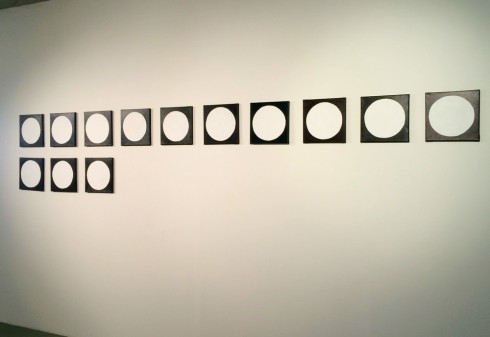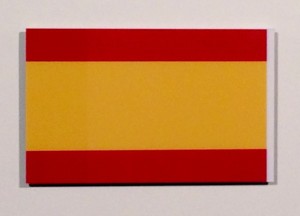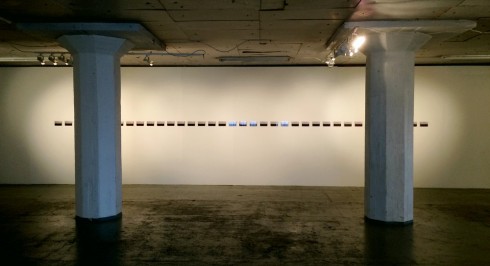Dropping into Galleria Huuto‘s Jätkäsaari branch recently made me feel like I had just travelled back in time. The destination was quite specific. It seemed I had arrived in New York City, Manhatten to be particular. I found myself standing in a well curated show of minimalist and conceptual art, the likes of which were shown at galleries operated by Leo Castelli, Ileana Sonnabend and Paula Cooper. In the mid-1970s these galleries were all situated south of Houston Street in the area people were beginning to call SOHO.
Surprisingly, the experience didn’t feel nostalgic; it was more like being inundated by a blast of fresh air. Despite all the hallmarks – a crisp, pared down presentation, rows of serialised imagery, a near monochrome palette and a general absence of expressive brushwork – the works on show conveyed no sense of redundancy. Created by Robin Lindqvist, they speak to the here and now.

For starters, 13 Moons (For On Kawara) plays off of the informational character of On Kawara’s Date Paintings, a series of canvases in which the artist painted each day’s date in white on a dark ground. Similarly, the production of each of Lindqvist’s paintings coincides with a full moon, but by substituting the lunar cycle for the calendric system, he is neither diaristic or notational. Instead, spiritual, superstitious or tragic associations are connoted and it shifts the viewer’s attention to far less mundane occurrences. This introduction also highlights the exhibition’s foreboding air.

Around the corner Lindqvist intersperses Jasper Johns’ cross hatching with a Sol LeWitt style wall drawing to create a doorway-shaped entity filled with a seemingly impenetrable dense dark thicket. It’s title, Enter Now the World, seemingly contradicts that imperative or, at the minimum, suggests a painfully tedious undertaking. In The Diagonal of April 24, 2016 he compresses light’s effect on space into a tiny digital painting. The work harks back to Dan Flavin’s Diagonal of May 25, 1963, an important early work, which Flavin believed was available to anybody and “had the potential for becoming a modern technological fetish.” (1) This is very much the case for the capabilities of today’s smart phones and tablets. The virtually ubiquitous forms of technology give us the opportunity to wade through ever increasing amounts of information, to add to it, to manipulate it and, in turn, be manipulated by it.

The exhibition’s sweep also takes us to Spain and East Africa. Lindqvist isolates a segment of Picasso’s Guernica variously described as the bomb, eyeball or light. Bombilla, its title, does double duty. In addition to being the Spanish word for bulb, it is also very close to the word for bomb.(2) Isolated from its original context, which illustrates the tragedies of armed conflict, the image appears cartoony, even decorative. I can, for example, see it embellishing t-shirts or hanging in a restaurant. Perhaps the artist includes it because he wants to remind us of the speed with which unexpected events can occur or as a means of altering perception. This light doesn’t merely illuminate, but it blasts through the painting’s greyness. It, in effect, dispels the greyness in which we too are mired.
Hanging next to this work is another digital painting – the miniscule Spanish Flag with Hope – that situates itself between national symbol and a formal colour study.

The image recalls Barnet Newman’s canvases and the white stripe that runs along its right edge resembles the lines – ‘zips’ he called them – that pass through or articulate his colour spaces, but the way it operates is totally different. That white line seems to bleed out from behind the ink and it throws the composition’s proportions off balance. It stands as a point of comparison that engenders questions as to the meanings attached to that flag – any flag, in fact. For some the colour bars represent something very specific; for others they’re much more nebulous. That white line directs attention toward the future. It speaks about unspecified desires and potentialities.

Thinking about the future is also what lies behind Thirty-Six Views of Mount Kilimanjaro, a horizontally oriented strip of postcard size photos that for me remains the undeniable highlight of the exhibition. In looking at these atmospheric images my mind drifted to the work of artists such as Hiroshi Sugimoto, Ed Ruscha, Bernd and Hilla Becher and, especially, Erin Sherriff, whose video Roden Crater was shown in Helsinki earlier in the year. That work resembles a time lapse video that shows the crater from the same perspective as it passes through a broad range of climate conditions. The twist is that Sherriff never travelled anywhere near the crater. All of the images were culled from the Internet.
I expected Lindqvist had also lifted the image of the mountain from some unspecified source, but this wasn’t the case. He actually travelled to Tanzania to photograph the dormant volcano famous for its white cap of snow and ice. Speaking to the artist I learned only a few seconds separate each exposure. The images are not identical. He also noted how the white cap is disappearing at a rapid rate. Furthermore, Shoji Kato writes that the work directly references Hokusai’s Thirty-Six Views of Mount Fuji and also signals, albeit subtly, Muybridge’s studies of movement.(3) Indeed, looking closely it can be seen that the photos do document the movement of a cloud wisp.
Of interest is also how the exhibition’s title evokes the names of films focusing on imminent disasters or dystopian futures. It brings 1984 and 2012 to mind, as well as Metropolis, which is set in the not too distant year of 2026. The scenarios 2017 presents, though, are much more modest and the future to which it refers is just on our doorstep. These works instigate a panoply of ideas and feelings that leave the mind buzzing, primarily because they make it clear that sorting through the complexity and problems of our world is no easy task. Their restrained presence is initially deceptive, but for those dedicated to looking and considering the ramifications of the content, they are also extremely effective.
Robin Lindqvist: 2017, Galleria Huuto, Jätkä 1, Jätkäsaari, Helsinki, 7.-22.5.2016
References:
- http://www.spanish-art.org/spanish-painting-guernica.html
- Shoji Kato, Reserved for Politics and Poetics, exhibition text.
